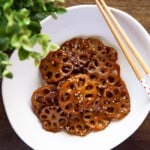Korean Braised Lotus Root (Yeongeun Jorim) - Tender and Moreish
Sweet and salty Korean braised lotus root is tender yet slightly crunchy, coated in a glossy soy-based glaze. This easy side dish recipe is ready in 20 minutes and tastes even better the next day.
Servings: 8
Calories: 76kcal
Ingredients
MAIN
- 260 g lotus root (9.2 oz), (fresh: peel and slice; frozen: use ready-sliced, rinsed and drained)
- 750 ml water (3 cups)
- 1/8 tsp apple cider vinegar or rice vinegar
- 1 Tbsp neutral cooking oil – e.g., rice bran oil
SAUCE
- 80 ml water (1/3 cup), or 125 ml (1/2 cup) kelp stock (see Step 2)
- 1 small piece dried kelp (kombu), about 3 cm / 1 inch, optional (for making kelp stock)
- 2 1/2 Tbsp soy sauce , Sempio 701 Yangjo Ganjang or Kikkoman brand
- 1/2 Tbsp sweet rice wine (mirin)
- 1 tsp minced garlic
- 1/2 tsp dark brown sugar
- 3 Tbsp golden syrup or Korean rice syrup (ssalyeot) or light corn syrup
TO FINISH
- 1/2 tsp toasted sesame oil
- 1 tsp toasted sesame seeds
Instructions
- Blanch the lotus rootIn a pot, bring 3 cups (750 ml) water and the apple cider vinegar to a boil. Add the lotus root and blanch for 2 to 3 minutes if using frozen slices, or 4 to 6 minutes if using fresh. Drain well and set aside.
- Prepare the sauceIf using kelp stock: Soak a small piece of dried kelp (kombu) in 1/2 cup (125 ml) water for 10 minutes, then remove the kelp. Add the soy sauce, mirin, garlic, and brown sugar directly to the kelp water, stirring until the sugar is fully dissolved. If using plain water, combine these ingredients with 1/3 cup (80 ml) water instead.
- Simmer with sauceIn a wide non-stick pan or braiser, heat the cooking oil and add the blanched lotus root. Stir briefly over medium heat. Add the prepared sauce and stir until the slices are evenly coated. Continue cooking until the liquid reduces to about one-third of its original volume and begins to thicken.Add the golden syrup (or rice syrup, or corn syrup) and stir continuously over medium to medium-low heat until the sauce turns glossy and coats the lotus root. If it begins to dry out too much, reduce the heat to prevent burning.
- Finish and serveWhen the sauce is mostly reduced, add the sesame oil and sesame seeds. Give it a quick stir to combine. Serve at room temperature or chilled.
Notes
Vinegar - Keeps the lotus root pale, gently mellows its earthy flavor, and gives a clean, refreshing finish.
Kelp Stock - Water works fine, but kelp stock adds a subtle umami depth that makes the sauce more rounded.
Fresh vs Frozen Lotus Root - Fresh is best: peel, slice evenly, and blanch a little longer. Frozen is a great alternative. I like the kind for Japanese renkon chips (thin and uniform). Other frozen varieties can be thicker, so check before cooking; they may need extra blanching or simmering.
Soy Sauce - Korean soy sauce gives the best flavor. My family's pick is Sempio 701 Yangjo Ganjang, with Kikkoman as a close second.
Golden Syrup - Adds a caramel-like sweetness with gentle toffee notes and a glossy amber finish. I use the CSR brand. Not traditional, but I find it works even better than rice syrup or corn syrup here.
Korean Rice Syrup - A good substitute if you can't find golden syrup. It gives a glossy finish and gentle sweetness with a hint of malty, nutty depth that corn syrup can't match.
Serving - Tastes best after chilling a few hours, when the glaze sets and the texture turns chewy with a gentle crunch. Serve cold or at room temperature with rice, kimchi, seasoned seaweed, or in a dosirak (Korean lunchbox). Also pairs beautifully with Korean BBQ.
Storage - Keeps well for 3 to 4 days in the fridge. After that, it starts to release moisture, softening the glaze and flavor.
Nutrition
Calories: 76kcal | Carbohydrates: 13g | Protein: 2g | Fat: 2g | Saturated Fat: 0.2g | Polyunsaturated Fat: 1g | Monounsaturated Fat: 1g | Trans Fat: 0.01g | Sodium: 333mg | Potassium: 196mg | Fiber: 2g | Sugar: 7g | Vitamin A: 0.4IU | Vitamin C: 14mg | Calcium: 23mg | Iron: 1mg
